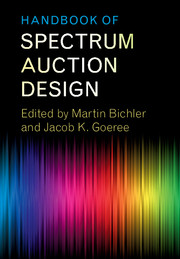Book contents
- Frontmatter
- Contents
- List of Contributors
- Preface
- List of Papers
- Part I The Simultaneous Multiple-Round Auction
- Part II The Combinatorial Clock Auction Designs
- Part III Alternative Auction Designs
- 18 A Combinatorial Auction Mechanism for Airport Time Slot Allocation
- 19 A New and Improved Design for Multi-Object Iterative Auctions
- 20 Hierarchical Package Bidding: A Paper & Pencil Combinatorial Auction
- 21 Assignment Messages and Exchanges
- 22 The Product-Mix Auction: A New Auction Design for Differentiated Goods
- 23 The Continuous Combinatorial Auction Architecture
- 24 Coalition-based Pricing in Ascending Combinatorial Auctions
- Part IV Experimental Comparisons of Auction Designs
- Part V The Bidders’ Perspective
- Part VI Secondary Markets and Exchanges
- Outlook
- References
19 - A New and Improved Design for Multi-Object Iterative Auctions
from Part III - Alternative Auction Designs
Published online by Cambridge University Press: 26 October 2017
- Frontmatter
- Contents
- List of Contributors
- Preface
- List of Papers
- Part I The Simultaneous Multiple-Round Auction
- Part II The Combinatorial Clock Auction Designs
- Part III Alternative Auction Designs
- 18 A Combinatorial Auction Mechanism for Airport Time Slot Allocation
- 19 A New and Improved Design for Multi-Object Iterative Auctions
- 20 Hierarchical Package Bidding: A Paper & Pencil Combinatorial Auction
- 21 Assignment Messages and Exchanges
- 22 The Product-Mix Auction: A New Auction Design for Differentiated Goods
- 23 The Continuous Combinatorial Auction Architecture
- 24 Coalition-based Pricing in Ascending Combinatorial Auctions
- Part IV Experimental Comparisons of Auction Designs
- Part V The Bidders’ Perspective
- Part VI Secondary Markets and Exchanges
- Outlook
- References
Summary
Introduction
Theory, experiment and practice suggest that, when bidder valuations for multiple objects are super-additive, combinatorial auctions are needed to increase efficiency, seller revenue, and bidder willingness to participate (Bykowsky et al. 2000, Rassenti et al. 1982, Ledyard et al. 2002). A combinatorial auction is an auction in which bidders are allowed to express bids in terms of packages of objects. The now famous FCC spectrum auctions are a good example of the relevance of these issues. In 41 auction events from 1994 to 2003, the FCC used what is known as a Simultaneous Multiple Round (SMR) auction to allocate spectrum and raise over $40 billion in revenue. This auction format does not allow package bidding. The FCC auctions also divide the spectrum by geographic location. It is reasonable to expect that some bidders might receive extra benefits by obtaining larger, more contiguous portions of the spectrum. A firm might enjoy cost savings if they could purchase two adjacent locations. However, without package bidding, a bidder cannot express that preference, potentially lowering the efficiency and revenue of the auction. If the bidder attempts to acquire both licenses through bidding on the licenses individually, they might be forced to expose themselves to potential losses. The high number of bidder defaults on payments might, in part, be evidence of losses caused by the lack of package bidding. In response to these difficulties, the FCC plans to allow package bidding in future auctions (Federal Communications Commission 2002, Dunford et al. 2001). In particular, the FCC in its auction #31 for the upper 700 MHz band, affords bidders the ability to submit bids for packages of licenses. The particular design presented in this paper was developed prior to the FCC package auction design. Indeed one of the major features of the FCC design was clearly influenced by the pricing rules we developed herein.
- Type
- Chapter
- Information
- Handbook of Spectrum Auction Design , pp. 391 - 417Publisher: Cambridge University PressPrint publication year: 2017
References
- 1
- Cited by



